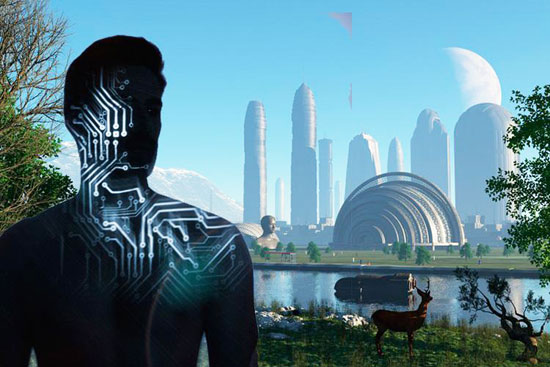Why transhumanists’ search for earthly immortality is misguided
For all the reports on the sordid life of Jeffrey Epstein, little has been written about his interest in transhumanism. Followers of the transhumanist movement believe humans will achieve super-longevity, and, perhaps one day, live forever.

Ray Kurzweil, director of engineering at Google and the author of books predicting a coming technological “singularity,” is perhaps the most prominent transhumanist.
The singularity refers to the date when machines obtain human intelligence; Kurzweil sees that happening by 2045. He foresees people “merging with the [machine] intelligence we have created.”
Followers active in the movement, like Kurzweil, take an unfathomable number of nutritional supplements each day. Those supplements supposedly slow the aging process, allowing time for science to kick in and enable transhumanists to achieve immortality. Some transhumanists believe their consciousness will be uploaded into a machine or a new body, or perhaps even a younger cloned version of themselves.
As one follower of Kurzweil puts it:
“As a true digital-cerebral interface comes into existence and we are able to ‘upload’ our memories and consciousness into a twin computer backup, true human immortality will follow automatically as a matter of course. This creation of a twin consciousness of self on the digital plane will be the defining moment of The Singularity. For as soon as this is done, and we are able to create backup copies of ourselves, by definition, we’re immortal.”
The entire transhumanist movement is based on the premise that the seat of our consciousness is in our brains. Are our thoughts nothing more than a bunch of “electrochemical reactions” as our brain neurons send their signals?
Scientists have never been able to prove the brain is the seat of consciousness. Some scientists hypothesize that consciousness is non-local, residing “in a field surrounding the brain in another dimension.” Such theories posit our “body [is] a conduit and a collaborator with consciousness.”
If consciousness is not located in the brain, those dreaming of endlessly downloading their essence into better bodies will never have their dreams of longevity fulfilled.
But is their dream of perpetual life a good one in the first place? Perhaps transhumanists have a distorted understanding of the meaning of life.
In her classic book aimed primarily at middle school children, Tuck Everlasting, Natalie Babbitt leads us to consider if the cycle of life is a blessing or a curse.
Tuck Everlasting tells the story of the Tuck family who, after drinking from a magical spring, stopped aging. The Tucks seemed to be living the transhumanist dream, but perpetual living taught them otherwise.
Babbitt opens her book with an evocative reminder of the “changeless sweep of change.”
“The first week of August hangs at the very top of summer, the top of the live-long year, like the highest seat of a Ferris wheel when it pauses in its turning. The weeks that come before are only a climb from balmy spring, and those that follow a drop to the chill of autumn, but the first week of August is motionless, and hot. It is curiously silent, too, with blank white dawns and glaring noons, and sunsets smeared with too much color.”
Winnie Foster is the novel’s protagonist with the task of deciding for herself whether to drink the spring’s waters. It is clear that the patriarch of the Tuck family is not enamored by his eternal life. He explains to Winnie that in nature nothing stays the same:
“Know what that is, all around us, Winnie?” said Tuck, his voice low. “Life. Moving, growing, changing, never the same two minutes together. This water, you look out at it every morning, and it looks the same, but it ain’t. All night long it’s been moving, coming in through the stream back there to the west, slipping out through the stream down east here, always quiet, always new, moving on. You can’t hardly see the current, can you? But it’s always there, the water’s always moving on, and someday, after a long while, it comes to the ocean.”
Eternal life is not natural, Tuck explains:
“Everything’s a wheel, turning and turning, never stopping. The frogs is part of it, and the bugs, and the fish, and the wood thrush, too. And people. But never the same ones. Always coming in new, always growing and changing, and always moving on. That’s the way it’s supposed to be. That’s the way it is.”
Tuck laments his longevity, resenting being stuck off the “wheel.”
“That’s what us Tucks are, Winnie. Stuck so’s we can’t move on. We ain’t part of the wheel no more. Dropped off, Winnie. Left behind. And everywhere around us, things is moving and growing and changing.”
Tuck adds, “Dying’s part of the wheel, right there next to being born. You can’t pick out the pieces you like and leave the rest. Being part of the whole thing, that’s the blessing.”
Without dying there is no living, Tuck learned, “So you can’t call it living, what we got. We just are, we just be, like rocks beside the road.”
Transhumanists would be aghast at the idea that their goal is to be “like rocks beside the road.” Yet, if they want to differ from the ‘whole thing,’ separated from all of life, will their dream of specialness be a blessing or a curse? Tuck Everlasting provokes us to reflect on what living really means.
yogaesoteric
November 8, 2019
